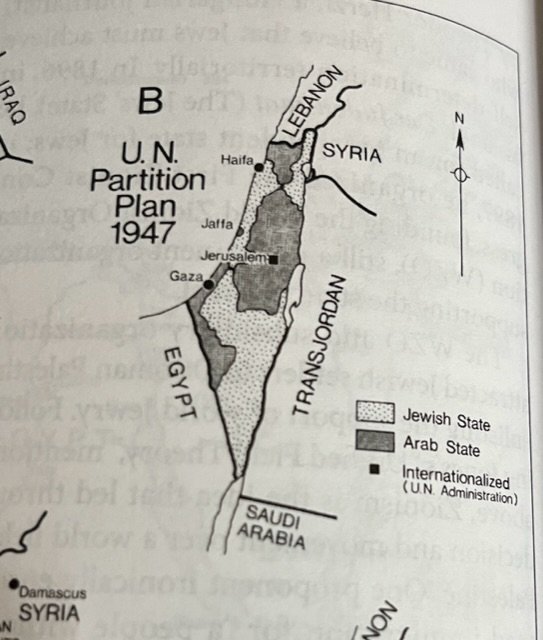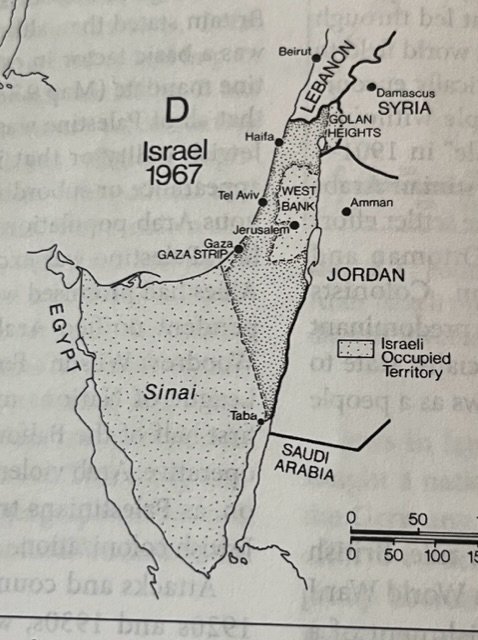The newly created United Nations inherited official authority over the Palestinian mandate in 1947 and proposed a partition of the territory into 3 separate states, an Arab Palestine with 43% of the territory, a Jewish Israel with 57%, and a UN-governed autonomous entity encompassing Jerusalem. At this time, Jews comprised 1/3rd of the population and owned only 7% of the land. Arabs in Palestine and beyond rejected the plan based on the disproportionate land area assigned to Israel.
The Jewish faction accepted the borders. As Arab members of the United Nations attempted to petition the legitimacy of the partition plan, and of the authority of the UN to even inherit the Palestinian mandate, Israel declared its independence. While not explicitly defining its borders, the Israeli Declaration included a commitment to work towards a partition plan along the UN scheme. Israeli forces sought to consolidate their claimed territory and in response, the surrounding Arab states of Syria, Iraq, Lebanon, and Egypt deployed military forces to combat them. Israel’s military was able to effectively take control of its proposed borders, as well as most of the areas of Jewish settlement, a 50% increase of land over the initial partition proposal. Amidst the fighting, numerous atrocities were committed and 800,000 surviving Palestinians were directly and indirectly displaced.
In 1949, all parties of what is usually referred to as the First Arab/Israeli War, signed an Armistice Agreement. The agreement demarcated ceasefire lines that were explicitly called out as temporary arrangements not meant to be borders. However, the fight over borders has never been officially resolved, leaving the conflict in a heightened state of tension that has periodically exploded ever since.
Second Arab/Israeli War (AKA the Suez Crisis, Tripartite Aggression, Sinai War)
Egyptian President Gamal Nasser was the leading figure in the Pan-Arab movement that gained steam after World War 2. As part of his campaign to decolonize Egypt, he nationalized the Suez Canal in 1956, leading to an invasion led by Britain and France that attempted to retain control of the Canal for the Western powers. Israel’s interest in joining the invasion was to regain access to the Straits of Tiran for its shipping industry. International pressure prevailed on the invading countries to abort their operations.
Third Arab/Israeli War (AKA Six Day War, June War)
While seen as a victory for Nasser, Israel regained access to the contested waterways at the end of the Suez Crisis. Nasser again announced them to be closed to Israeli vessels in May of 1967. He then ordered United Nations Emergency Force (UNEF) personnel that had been active in the area as peacekeepers since 1956, to evacuate and mobilized the Egyptian army along the border. Israeli forces struck Egyptian airfields in a preemptive strike that allowed them to gain the Sinai Peninsula. Israel also seized the West Bank and the rest of Jerusalem (both then part of Jordan), and the Golan Heights (then part of Syria).
Fourth Arab/Israeli War (AKA Yom Kippur War, Ramadan War, October War)
On October 6, 1973, Syrian forces crossed the ceasefire lines into the Golan Heights, and Egypt crossed those in Sinai. The surprise attack was met by Israeli forces who either repelled invading troops or held them in place. A stalemate soon solidified. The US and the Soviet Union rushed to resupply their respective allies. Many feared direct intervention by one of the superpowers that could lead to a wider conflict involving nuclear weapons. A ceasefire was negotiated by both sides and their allies. This diplomatic work continued and eventually led to the Camp David Accords in 1978 and the Egyptian-Israeli Peace Treaty in 1979, facilitating the return of the Sinai Peninsula to Egypt.
None of the territory taken in these conflicts has ever been recognized as legitimately part of Israel, however neither international pressure nor the threat of Arab aggression has kept Israel from building settlements and facilitating immigration into them.
Israel often asserts that its Arab neighbors do not recognize their right to exist. Besides Egypt and Jordan, most of the states in the Middle East do not formally recognize Israel. However, many people in these countries argue they simply do not recognize Israel’s right to retain all of the territory it has conquered. Officially, the United Nations does not either. US support for Israel has continued to shield it from international action, if not international condemnation.
In the wake of geopolitical gridlock on the issue, violent resistance came to define the Palestinian response, and de facto martial law has characterized Israel’s administration of not only its conquered territory, but much of Israel itself.
The source cited below is a textbook I used in 2017 in my “Middle East Geography” class. I elected not to add any online sources to this post, but there are many substantive ones available that I recommend readers seek out. My purpose in writing at length on a topic outside my field was to provide a brief overview of the key events involved with the founding of the modern territories of Palestine and Israel, and to highlight the involvement of colonial powers I believe bear partial responsibility for the ongoing violence.
Source:
“The Arab-Israeli Problem.” Middle East Patterns, 6th ed. p252-264. 2014. Colbert C. Held, John Thomas Cummings. Westview Press.
Maps:
“Territorial evolution of Israel, from Palestinian mandate to contemporary state, with occupied territories (part B-D)”
John V. Cotter. Middle East Patterns, 6th ed.



